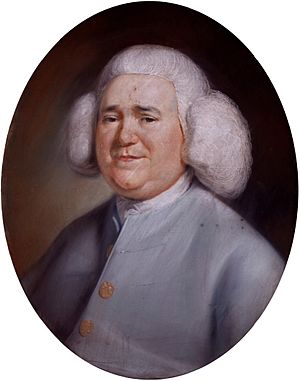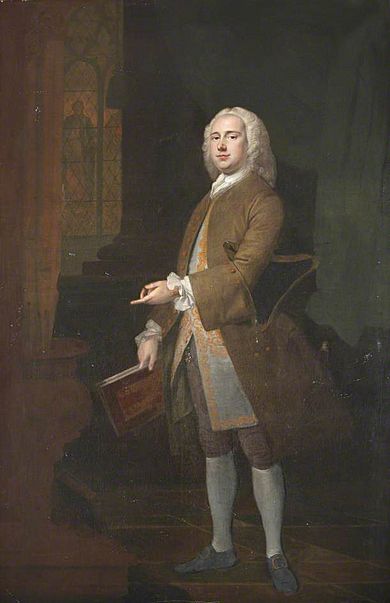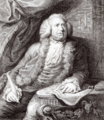William Boyce (composer) facts for kids
William Boyce (born in 1711, died in 1779) was a famous English composer and organist. He lived a long time ago, in the 1700s. Like the famous composer Beethoven, William Boyce became deaf. But even though he couldn't hear, he kept writing amazing music! He knew many other great musicians of his time, like Handel and a young Mozart. They all thought his music was excellent.
Contents
William Boyce's Life
Early Life and Training
William Boyce was born in London in 1711. His father, John Boyce, was a joiner and cabinet-maker. He was also an important official for the joiners' guild. William started as a choirboy at St Paul's Cathedral in 1719. This was a great place to learn about music. After his voice changed in 1727, he continued to study music. His teacher was a composer named Maurice Greene.
Becoming an Organist
Boyce got his first professional job in 1734. He became an organist at the Oxford Chapel in London. An organist plays the organ, a very large musical instrument. He then worked at several other churches. In 1757, he became the Master of the King's Musick. This was a very important job for the king's musicians. He also taught music to students. Two of his students were Thomas Linley the Elder and Thomas Linley the Younger.
Composing Music
Boyce started writing music in the 1730s. He wrote songs for popular places like Vauxhall Gardens. In 1736, he became a composer for the Chapel Royal. He wrote an oratorio called David's Lamentation over Saul and Jonathan. An oratorio is like a play set to music, but without acting or costumes.
He also conducted at the Three Choirs Festival starting in 1737. Many of his works were first played there. In the 1740s, he wrote an opera called Peleus and Thetis. He also wrote a serenata, Solomon. A serenata is a type of musical performance, often for a special event.
In 1749, he wrote music for Cambridge University. He received a special degree called Doctor of Music. His "Twelve Sonatas for Two Violins and a Bass" became very popular. People used them for concerts and even in theaters.
Music for the Stage and King
In the 1750s, Boyce wrote music for the Drury Lane Theatre. He worked with the famous actor David Garrick. Boyce wrote two of his own operas, The Chaplet and The Shepherd's Lottery. He also wrote music for a pantomime called Harlequin's Invasion. This pantomime included his most famous song, Heart of Oak.
As Master of the King's Musick, Boyce wrote music for royal events. This included funerals, weddings, and coronations. For the coronation of George III and Charlotte in 1761, he chose to use Handel's famous anthem Zadok the Priest. Boyce believed Handel's version was perfect. Because of this, Handel's anthem has been played at every British coronation since then. Boyce himself wrote eight other anthems for that coronation.
Later Life and Legacy
By 1758, Boyce's hearing became much worse. He was so deaf that he could no longer play the organ in churches. He decided to stop teaching and move to Kensington. He spent his time working on a collection of church music. This collection was started by his old teacher, Maurice Greene. Boyce edited works by composers like William Byrd and Henry Purcell. Many of these pieces are still used in church services today.
William Boyce died on February 7, 1779, at age 67. He was buried at St Paul's Cathedral. His only son, also named William Boyce, became a professional double bass player.
William Boyce's Legacy
Rediscovery of His Music
After he died, William Boyce was mostly forgotten for a long time. Not many people played his music. However, some of his pieces were found again in the 1930s. A musician named Constant Lambert helped bring Boyce's music back to life. He published the first modern edition of Boyce's Eight Symphonies in 1928.
Lasting Church Music
Boyce's church music was always important. After his death, his works were edited and published. These included Fifteen Anthems by Dr Boyce and A Collection of Anthems and a Short Service. In the 1830s and 1840s, there was a new interest in church choir music. A new edition of Boyce's Cathedral Music was published in 1849.
Royal Connections
Boyce's music is still played at important events today. The first part of his Symphony No. 1 was played at the wedding of Prince Harry and Meghan Markle in 2018. His coronation anthem The King Shall Rejoice was also performed at the coronation of Charles III in 2023.
Famous artists like Joshua Reynolds and Thomas Hudson painted portraits of William Boyce.
Works
See List of compositions by William Boyce
Images for kids
See also
 In Spanish: William Boyce para niños
In Spanish: William Boyce para niños




